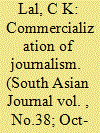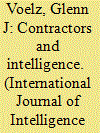|
|
|
Sort Order |
|
|
|
Items / Page
|
|
|
|
|
|
|
| Srl | Item |
| 1 |
ID:
101966


|
|
|
| 2 |
ID:
169342


|
|
|
|
|
| Summary/Abstract |
Iran has a long-standing and increasingly comprehensive space program. Given the current technological and political developments worldwide, a logical next step is to start commercializing some of the country's space activities. After first reviewing the literature on the commercialization of technology, this article describes Iran's space program and the various organizations involved in it, before presenting research based on interviews with 15 experts in the field of space commercialization. The results suggest that there are eight areas that Iran should concentrate on but that there are also currently several barriers to commercialization of the country's space industry. A conclusion provides recommendations for facilitating commercialization in the future.
|
|
|
|
|
|
|
|
|
|
|
|
|
|
|
|
| 3 |
ID:
109171


|
|
|
|
|
| Publication |
2011.
|
| Summary/Abstract |
This article examines recent shifts in Belgrade's urban geography and built environments, with an accent placed on landscapes of social cleansing, gentrification and commercialization accompanying Serbia's emerging neoliberal governmentality. It does so by exploring the convergent translocal discourses and institutional structures that provided financing, conditionality and legitimacy for the forcible displacement of a sizeable Roma community living under Belgrade's Gazela Bridge and their involuntary relocation into housing containers on the city's outskirts in late August 2009. The article juxtaposes the violence of this site-specific biopolitical intervention into Roma everyday life, which was executed by local city authorities and financed by European financial institutions, with the alternative strategies deployed by the community and its allies in contesting Belgrade's racialized urban restructuring. The Gazela episode illustrates how functional re-inscriptions of urban space for the translocal needs of capital can simultaneously generate both violent cartographies of dispossession and precarious forms of subaltern reterritorialization.
|
|
|
|
|
|
|
|
|
|
|
|
|
|
|
|
| 4 |
ID:
147612


|
|
|
|
|
| Summary/Abstract |
Front-line loan officers of microfinance institutions (MFIs) are important in acquiring information on potential borrowers and selecting them in accordance with the MFI's mission. We use a unique data set on loan officers and their loan portfolios from China's largest NGO microfinance institution to test whether officers' personal characteristics affect the size and quality of their loans. We study a period in which the institution shifted from reliance on government donations and subsidies to commercial sources of funding. Imposing more commercial incentives on loan officers could affect how they balance potentially competing objectives to serve the poor and pursue profitability. We find that loan officers who were formerly farmers or worked in local government were better able to maintain lending to poorer borrowers, without incurring substantially lower repayment rates on their loans. In short, it appears that the career backgrounds of loan officers did play a role in preventing mission drift.
|
|
|
|
|
|
|
|
|
|
|
|
|
|
|
|
| 5 |
ID:
119885


|
|
|
| 6 |
ID:
118357


|
|
|
| 7 |
ID:
105120


|
|
|
|
|
| Publication |
2011.
|
| Summary/Abstract |
Technology transfer agreements are necessary to fulfil technological needs that are impossible to meet with local technical capabilities. Traditional devices of licence transfer often fall within the purview of antitrust scrutiny and are deemed anti-competitive practices in general trade, as in the case of territorial restrictions in licensing. Antitrust laws, although fit to evaluate general trade agreements, often fail to address intricate problems involving IPR and therefore, lack the tools to adequately solve them. The blanket protection approach to IP as provided by Section 3(5) of the Indian Competition Act is equally ineffective due to lack of a mechanism to deal with IP-related unfair trade practices. The TRIPS under Article 40, permits member states to prevent abuse of IP through anti-trust legislations. India has permitted cross licensing under its patent laws but has failed to prevent its anti-competitive fallout in technology licensing. This article draws from the EU TTBE 2004 Regulations as well as the US antitrust guidelines to highlight the need for a balance between the two conflicting interests of competition policy and the protection of technological know-how. It further purports to set forth an adaptation of guidelines for India, keeping in mind the anti-trust laws of other jurisdictions.
|
|
|
|
|
|
|
|
|
|
|
|
|
|
|
|
| 8 |
ID:
091230


|
|
|
|
|
| Publication |
2009.
|
| Summary/Abstract |
At this juncture ongoing military operations and growing demand for domestic counterterrorism information will likely necessitate continuing reliance on private sector augmentation into the foreseeable future. Given this assumption, the time has arrived for the government to move beyond viewing its commercial augmentation as an ad hoc resource without having clear strategies and policy for its use.
|
|
|
|
|
|
|
|
|
|
|
|
|
|
|
|
| 9 |
ID:
159418


|
|
|
|
|
| Summary/Abstract |
Humanitarian nonprofit nongovernmental organizations (NGOs) today exhibit signs of “marketization” and behave like firms, according to a frequently uttered claim in the scholarly literature. However, it is not precisely clear what marketization and behaving like a firm mean. Drawing on the literature concerning nonprofit organizations and public administration, we offer a more sophisticated and multifaceted understanding of a consequential development for NGOs. Rather than merely equating “firm-like” with the adoption of corporate practices, we conceive of it as a mind-set. We suggest that “firm-like” involves not only marketization, but also corporatization and organizational rationalization. Based on a content analysis of the websites of a heterogeneous sample of nine humanitarian NGOs, we illustrate the potential of this conceptualization to shed light on a discourse among these organizations that appears to be self-referential and self-aggrandizing with respect to their capacities.
|
|
|
|
|
|
|
|
|
|
|
|
|
|
|
|
| 10 |
ID:
183406


|
|
|
|
|
| Summary/Abstract |
In the coming decade, intensifying competition between great powers will
have a significant impact on the development of space activities (SA) and
on the future of international cooperation in this field. The article examines
the scope, development paths and competitive advantages of individual
countries in the field of space activities, and explores fundamental issues
of competition and cooperation. A system analysis method is used to
assess current dynamics in this area. The U.S. is expanding cooperation
with its allies, while Russia is strengthening cooperation with China in the
SA field. We note the “securitization” of SA development processes and
emphasize the expansion of the “space” dimension of the international
security agenda. There is a danger that “natural competition” may turn
into “confrontation,” which is a key factor influencing, inter alia, the need
to change the form of organization, the principles, the strategy, and the
mechanisms of international cooperation. The article also substantiates the
need to strengthen the role of international cooperation in the SA field as
a “binding” component of global security.
|
|
|
|
|
|
|
|
|
|
|
|
|
|
|
|
| 11 |
ID:
099362


|
|
|
|
|
| Publication |
2010.
|
| Summary/Abstract |
Are public R&D programs really effective in developing innovative technologies? How many technologies developed in these programs have been successfully commercialized? What are the key factors for successful commercialization and diffusion in the market? This paper tries to answer these questions by examining the Japanese experience of public R&D in demand-side energy efficiency, focusing on two major projects conducted in the 1980s and 1990s. It is found that of the 34 technologies developed in the two projects, only seven have been commercialized so far, four of those seven have only a very limited number of installations, and only one has a growing market. The results show that, while public R&D investments have a high risk of failure, they can bring new technologies to the market after a certain lead time. In addition, several factors resulting in the success or failure of commercialization/diffusion are identified, such as long-term R&D support by the government, a marketing strategy to respond to and influence market demand, and combination of R&D and deployment policy.
|
|
|
|
|
|
|
|
|
|
|
|
|
|
|
|
| 12 |
ID:
132717


|
|
|
|
|
| Publication |
2014.
|
| Summary/Abstract |
In 2009 President Obama proposed a budget for the National Aeronautics and Space Administration (NASA) that canceled the Constellation program and included the development of commercial crew transportation systems into low Earth orbit. This significant move to shift human spaceflight into the private sector sparked political debate, but much of the discourse has focused on impacts to "safety." Although no one disputes the importance of keeping astronauts safe, strategies for defining safety reveal contrasting visions for the space program and opposing values regarding the privatization of U.S. space exploration. In other words, the debate over commercial control has largely become encoded in arguments over safety. Specifically, proponents of using commercial options for transporting astronauts to the International Space Station (ISS) argue that commercial vehicles would be safe for astronauts, while proponents of NASA control argue that commercial vehicles would be unsafe, or at least not as safe as NASA vehicles. The cost of the spaceflight program, the technical requirements for designing a vehicle, the track record of the launch vehicle, and the experience of the launch provider are all incorporated into what defines safety in human spaceflight. This paper analyzes these contested criteria through conceptual lenses provided by fields of science and technology policy (STP) and science, technology, and society (STS). We ultimately contend that these differences in definition result not merely from ambiguous understandings of safety, but from intentional and strategic choices guided by normative positions on the commercialization of human spaceflight. The debate over safety is better considered a proxy debate for the partisan preferences embedded within the dispute over public or private spaceflight.
|
|
|
|
|
|
|
|
|
|
|
|
|
|
|
|
| 13 |
ID:
108831


|
|
|
|
|
| Publication |
2011.
|
| Summary/Abstract |
Korea's space development program was created almost 40 years behind those of the advanced countries but it has nevertheless made remarkable progress. Korean space development has been focused on technology catch-up, where commercialization and growth of industrial competitiveness are important rationales. However, the program has several problems, including: lack of a space equipment manufacturing industry, total system companies in the space manufacturing industry and communication between industry and researchers, and much concentration of projects and initiatives in the Korean Aerospace Research Institute (KARI). This study analyzes the problem by comparing space agencies and programs in Korea and other countries, particularly Japan and the USA. It is shown that the role of a national laboratory is critical in space industry development and argued that KARI should make greater efforts to promote the Korean space industry by encouraging technology transfer, sharing equipment and communication between companies. For successful space development, the main organization - usually the national research institute - should change its role from a research-only laboratory to manager and supporter of space development and industry. Such a move would invigorate Korea's space industry and allow it to catch up with countries with a similar environment.
|
|
|
|
|
|
|
|
|
|
|
|
|
|
|
|
| 14 |
ID:
101938


|
|
|
|
|
| Publication |
2011.
|
| Summary/Abstract |
The television play has been recognized by scholars as the most influential genre in the flourishing television industry in China's new media landscape; yet little critical attention has been given to inquiry of why and how it functions as a dynamic cultural agent in the Chinese people's reconfiguration of their past and imagining of their everyday life. This paper investigates the intriguing socio-historical environment from which the genre emerged and its unique modes of operation by focusing on the television play of sentiment. It demonstrates that the television play embodies the many complex aspects of social forces and relationships contested in China's reform, suggesting, all at once, commercialization in Chinese society, the popular imaginary of morality and the state's conceptualization of a 'harmonious society', a strategic policy aiming at maintaining social balance while bypassing some of the thorny political questions in the post-revolution era.
|
|
|
|
|
|
|
|
|
|
|
|
|
|
|
|
|
|
|
|
|